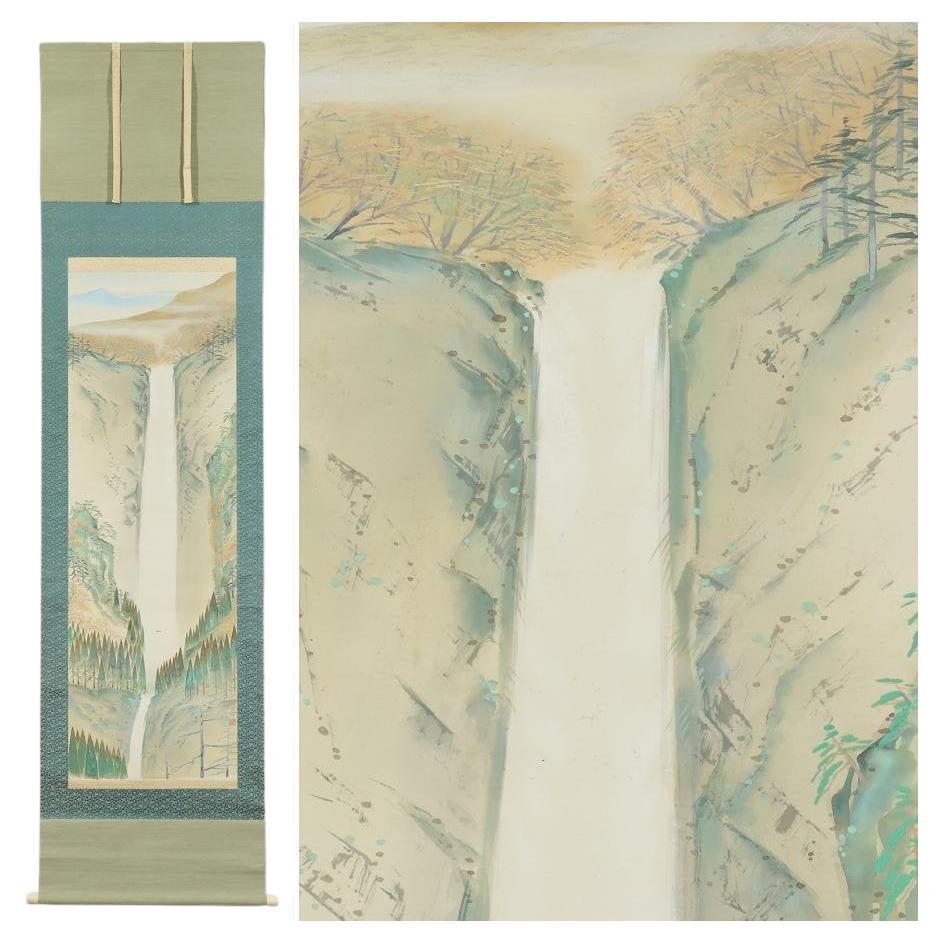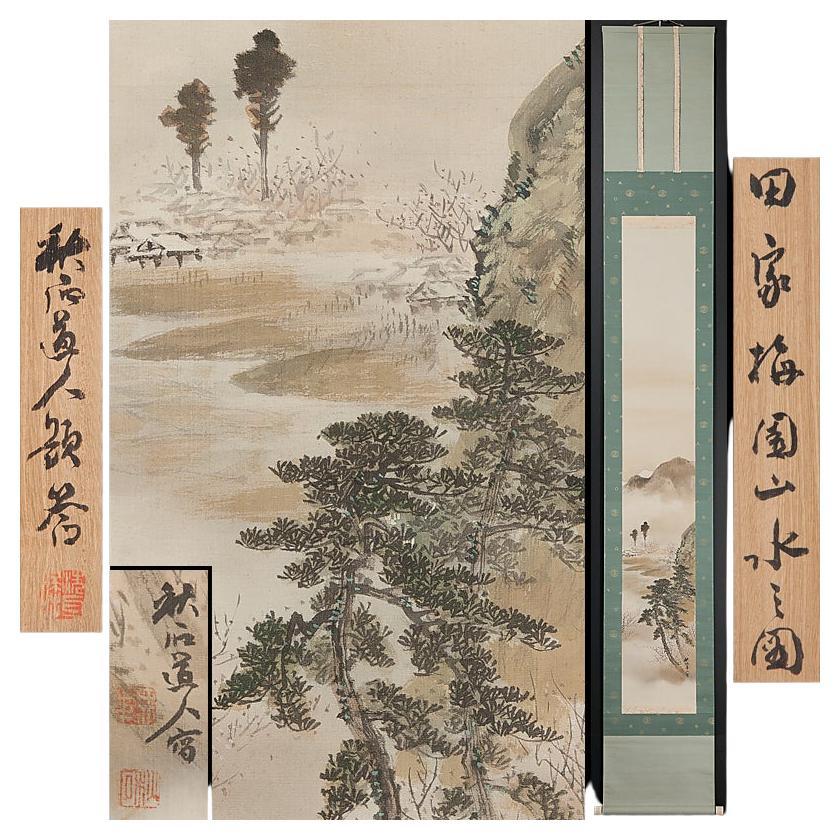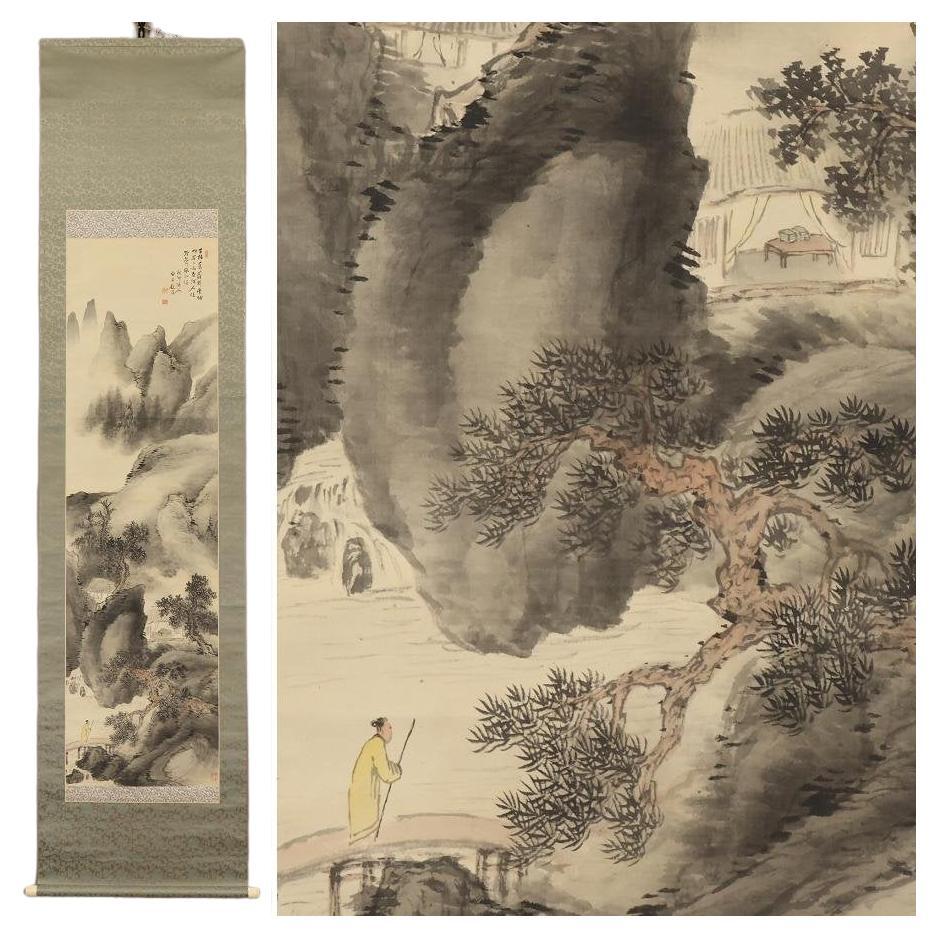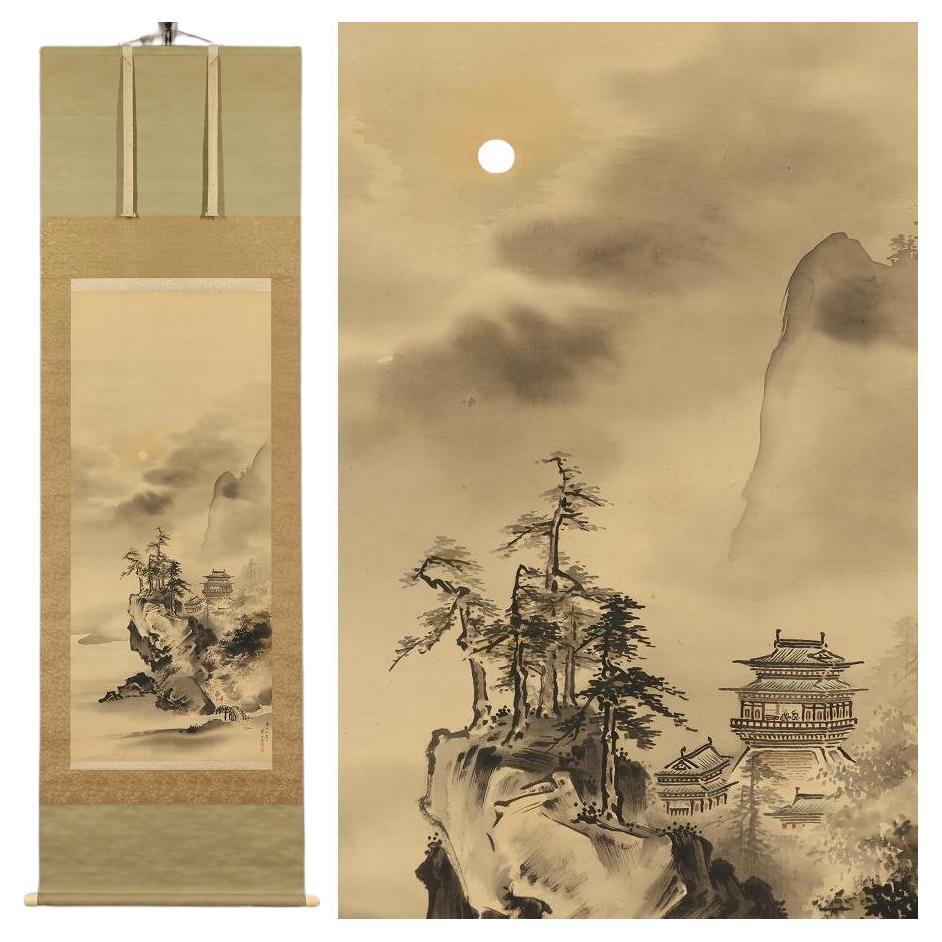Items Similar to Japanese Painting Meiji / Taisho Period Scroll by Dokuzan Hashimoto Zen Buddhism
Want more images or videos?
Request additional images or videos from the seller
1 of 11
Japanese Painting Meiji / Taisho Period Scroll by Dokuzan Hashimoto Zen Buddhism
About the Item
Hashimoto Dokuzan was a leading figure in early twentieth-century Zen Buddhism, serving as abbot of the major monastery Shōkokuji in the city of Kyoto and served as chief, kanchō, of the Shōkokuji branch of the Rinzai sect of Zen from 1909 to 1933. Before he entered the priesthood, he trained to be a painter under the celebrated literati artist Tomioka Tessai and continued to paint throughout his life. The present worked shows a lone Chinese man in a deep woods, leaning over the railing of a stone bridge to gaze at rushing stream below—a scene of communion with nature that East Asian painters have turned to and reinterpreted for a thousand years. Painted entirely in ink, Hashimoto contrasts the dry, detailed brushwork of the figure, bridge, and the foreground landscape motifs with soft wet dots in a range of dilute ink for the trees’ dense foliage.
[Authentic work] ◆ Dokuzan Hashimoto (Dokuzan Hashimoto) ◆ Landscape of plum blossoms ◆ Double box ◆ Niigata Prefecture ◆ Hand-drawn ◆ Paper ◆ Hanging scroll ◆
Dokuzan Hashimoto (Dokuzan Hashimoto)
[ Artyearbook evaluation Frame: 1.4 million yen] Japanese painting, calligrapher, monk, Southern painter 1869 (Meiji 2) - 1938 (Showa 13) Real name: Matsujiro (childhood name), Hyeongi, Jishu (both Buddhist names) Character: Dokzango : Taiunkutsu, Nanen [Birthplace/Teacher lineage] Born in Niigata Prefecture Teacher, Tessai Tomioka [Affiliation/Title] 3rd head of the Shokokuji school, 128th head of the Shokokuji school [Brief history/style, etc.] We aspire to be painters. At the age of 16, he became a disciple of Tessai Tomioka, but later attained a degree at Tenryu-ji Temple and entered the Buddhist monastery, becoming the chief priest of Rakuo-in, the sub-temple of Tenryu-ji Temple, and the head of the Shokoku-ji sect. After his retirement, he opened Nanen-ji Temple in Tottori Prefecture and spent the rest of his life devoted to painting and calligraphy. His paintings are mainly Nanga landscapes.
This work is a ``Plum Blossom Landscape'' drawn by hand and on paper. The box is a double box. The paper has some spots, small wrinkles, and creases, but is generally in good condition. There are some small stains and wrinkles on the cover, but it is generally in good condition.
This is a guaranteed genuine product, so please bid accordingly.
Size: Approximately [Height 209cm x Width 45cm/(Main paper) 144cm x 33cm]
- Dimensions:Height: 82.29 in (209 cm)Width: 17.72 in (45 cm)Depth: 0.04 in (1 mm)
- Style:Taisho (Of the Period)
- Materials and Techniques:
- Period:1900-1909
- Date of Manufacture:1900
- Condition:Wear consistent with age and use.
- Seller Location:Amsterdam, NL
- Reference Number:
About the Seller
5.0
Gold Seller
These expertly vetted sellers are highly rated and consistently exceed customer expectations.
Established in 2015
1stDibs seller since 2019
158 sales on 1stDibs
Typical response time: 8 hours
- ShippingRetrieving quote...Ships From: Amsterdam, Netherlands
- Return PolicyA return for this item may be initiated within 14 days of delivery.
More From This SellerView All
- Japanese Painting Taisho / Showa Period Scroll by Tadashi Mamiya LandscapeLocated in Amsterdam, Noord Holland[Authentic Artwork] ◆ Tadashi Mamiya ◆ Waterfall ◆ Japanese Painting ◆ Saitama Prefecture ◆ Hand-Painted ◆ Silk ◆ Hanging Scroll Discover the serene beauty of Tadashi Mamiya's "Wate...Category
Vintage 1930s Taisho Paintings
MaterialsSilk
- Japanese Painting Taisho / Showa Period Scroll by Yazawa Gengetsu LandscapeLocated in Amsterdam, Noord Holland[Authentic work] ◆ Gengetsu Yazawa ◆ Mountain and Lake Off Day ◆ box ◆ Landscape ◆ Nagano Prefecture ◆ Handwritten ◆ Paperback ◆ Hanging scroll ◆ Gengetsu Yazawa Art yearbook appr...Category
Vintage 1930s Taisho Paintings
MaterialsSilk
- Japanese Nihonga Painting 1900 Meiji/Taisho Scroll Shûseki, Okutani LandscapeLocated in Amsterdam, Noord HollandSusheki Okutani "Takaya Plum Garden Landscape" Silk, Colored, Authentic, Hanging Scroll, , Double Box size Axis: Height 206.5cm Width 29.3cm Drawing…Height 126.7cm Width 19.5cm *There may be slight differences in dimensions. Thank you for your understanding. situation It is in good condition, but please note that there are some light stains. Please check the image for details. Thank you for your support. Biography Akishi Okutani Japanese painter. Born in Osaka. His name is Tsunejiro. He studied under Kansai Mori. From an early age, he exhibited his works at the Japan Painting Association and the Young People's Painting Association, which was led by Gaho Hashimoto and Gyokusho Kawabata, and won numerous awards. He also opened a private school...Category
20th Century Taisho Paintings
MaterialsSilk
- Japanese Painting Taisho / Showa Period Scroll by Shuson Kono Nanga LandscapeLocated in Amsterdam, Noord HollandAuthentic work ◆ Shuson Kono ◆ Illustrated landscape of the literati ◆ Shared box ◆ Landscape ◆ Ehime Prefecture ◆ Handpainted ◆ Silk ◆ Hanging scrol...Category
Vintage 1930s Taisho Paintings
MaterialsSilk
- Japanese Painting Taisho / Showa Period Scroll by Torei Ogita Nanga LandscapeLocated in Amsterdam, Noord Holland[Authentic work] ◆ Torei Ogita ◆ fishing boat ◆ Double box ◆ Master: Komuro Sogumo ◆ Tochigi Prefecture ◆ Hand-painted ◆ Silk ◆ Hanging scroll ◆ Torei Ogita 1899 ~Died in 1979 at t...Category
Vintage 1930s Taisho Paintings
MaterialsSilk
- Japanese Painting Taisho Period Scroll by Inaba Midorida Nihonga - Moon TowerLocated in Amsterdam, Noord HollandInaba Midorida ◆ Landscape view of the Moon Tower ◆ Meiji 33 ◆ Nagano Prefecture ◆ Shinshu Matsushiro clan samurai ◆ Hand-drawn painting ◆ Silk book ◆ Hanging scroll ◆ s829 ◆ Inaba...Category
Vintage 1930s Taisho Paintings
MaterialsSilk
You May Also Like
- Large Antique Japanese Scroll Depicting a Nesting Crane, Taisho PeriodLocated in Prahran, VictoriaLarge and exceptional Japanese hanging scroll with a realistically painted depiction of a nesting crane by Yoshifuji Yoshio, Taisho/Showa perio...Category
Early 20th Century Japanese Taisho Paintings and Screens
MaterialsPaper, Silk
- Japanese Painting, Hanging Scroll, 'Playful Cat' by Hirose Toho, 1920s TaishoBy Hirose TohoLocated in Kyoto, JPPlayful Cat Hirose Toho (1875-1930) Hanging scroll, ink, mineral pigments and gofun on silk. Painting inscription: Toho Sha Painting seals: Upper - Hirose Hitoshi Lo...Category
Vintage 1920s Japanese Taisho Paintings and Screens
MaterialsSilk
- Japanese Meiji Riverside Scroll Painting, c. 1900Located in Chicago, ILAlthough western painting was initially embraced during Japan’s Meiji period (1868-1912), artists brought on a revival of traditional painting styles as they sought to create a modern Japanese style with roots in the past. This exquisite hanging scroll demonstrates the preference for soft layering of gray tones with judicious use of color. The landscape is rendered in soft ink washes that subtly distinguish between water, mountain, and sky. The scroll painting...Category
Early 20th Century Japanese Meiji Paintings and Screens
MaterialsPaper
- Japanese Bijin-ga Painting of Woman in Period Kimono, Taisho Period, circa 1920Located in Prahran, VictoriaRare Japanese Taisho period Bijin-ga style painting of a beautiful woman in period kimono holding a fan, circa 1920. Bijin-ga is a Japanese term used to describe paintings or pict...Category
Vintage 1920s Japanese Taisho Paintings and Screens
MaterialsSilk
- Rare Triptych Scroll Paintings by Watanabe Seitei Meiji PeriodLocated in Atlanta, GAA set of three paintings of ink and watercolor on silk mounted within brocade borders as scrolls by Watanabe Seitei (1851-1918). This is a very rare an...Category
Antique Early 1900s Japanese Japonisme Paintings and Screens
MaterialsBrocade, Silk, Wood
- Antique hanging scroll of Japanese cat/Late Edo-Meiji period/Cat paintingLocated in Sammu-shi, ChibaThis is a picture of a cat drawn by a person named "Toshizumi Nitta" from the end of the Edo period to the beginning of the Meiji period. She is a very simple and cute cat. He is a vassal of the Tokugawa Shogunate, born in Ota City, Gunma Prefecture (southern part of Gunma Prefecture). He was related to the Tokugawa family and lived in a large mansion in the Ota clan in Gunma prefecture. However, the Nitta family's territory was very small, and they were by no means a wealthy vassal. He seems to have lived quite poorly. So he painted cats and sold them to people. The Nitta family continued to draw pictures of this cat for four generations. "Nitta toshizumi" is equivalent to the fourth generation. During the Edo period, sericulture was thriving in the Kanto region. Cats were said to be the gods of silkworms, as they drive away mice, the natural enemies of silkworms. It was the Nitta family who drew such a cat on paper, pasted it in the silkworm chamber, and sold it as a mouse repellent. There were also other monks who painted pictures of cats, but the Nitta family in particular was related to the Tokugawa family, so people believed that paintings of cats had special powers. , a lot of paintings...Category
Antique Late 19th Century Japanese Edo Paintings
MaterialsPaper





